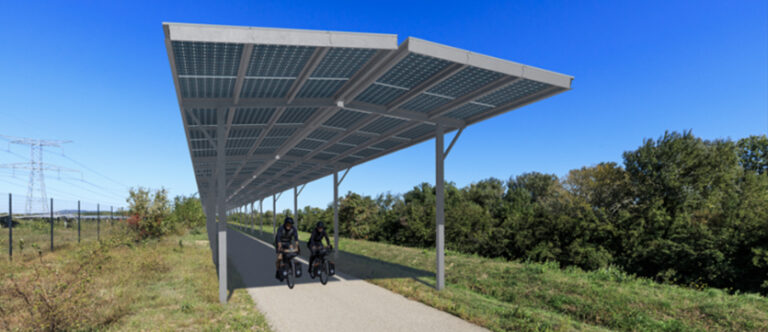A consortium is installing an experimental linear shade-house solar farm in Vaucluse, southern France, using high-voltage DC architecture to reduce electricity losses.
A nearly kilometer-long high-voltage direct current PV project will be tested along the ViaRhôna cycle route in the Rhône Valley, a first for France.
The Ophélia project, supported by the French environmental agency Ademe under the ‘France 2030’ programme, involves Nexans, Schneider Electric, SNCF, the SuperGrid Institute and Compagnie nationale du Rhone (CNR). Construction recently started in Caderousse, Vaucluse, on six shade structures consisting of two-inclined arrays with three rows of 615 W bifacial monocrystalline modules, with a total power of 1 MW.
The civil engineering, erection of the structure and installation of the canopy will continue until the first quarter of 2025. The project is expected to be operational in September 2025, while instrumentation monitoring will continue until 2028 to manage the experiment.
The “Viasolaire du Colombier” pilot project uses an innovative electrical design to minimize losses by transmitting electricity via high-voltage direct current instead of alternating current.
“Unlike a traditional park where the electricity from the modules (1,500 VDC voltage) is converted into alternating current (800 VAC) via inverters located in the immediate vicinity of the module strings, the collected electricity on a linear photovoltaic park is transferred transported to multiple locations. kilometers, or even several tens of kilometers, to the delivery station, potentially causing greater electrical losses,” said Romain Jacquet, head of media relations and digital communications at CNR. pv magazine France.
The proposed solution consists of significantly increasing the DC voltage near the PV module strings via DC/DC converters and then transporting the high-voltage DC current to the delivery station where it is converted into AC current.
“A high voltage makes it possible to reduce the current and thus the losses in the Joule effect for the same power. In addition, direct current transmission avoids losses associated with the formation of reactive energy, which is unavoidable with alternating current,” said Jacquet.
The pilot project serves as a platform to develop laboratory prototypes and test them under real-world conditions, addressing the challenges arising from a lack of market-ready equipment. It includes DC/DC converters from the SuperGrid Institute, high-voltage DC cells from Schneider Electric and custom cables from Nexans, with a focus on improving reliability during normal operation, transients and insulation levels.
The Ophélia project marks a significant technological advance for linear solar photovoltaics along roads, cycle routes, riverbanks and railways. CNR said this segment could add almost 35 GW of capacity, supporting France’s solar targets of 54 GW to 60 GW by 2030 under the third multi-annual energy programming plan, without harming the natural environment by using already artificial surfaces.
This content is copyrighted and may not be reused. If you would like to collaborate with us and reuse some of our content, please contact: editors@pv-magazine.com.


